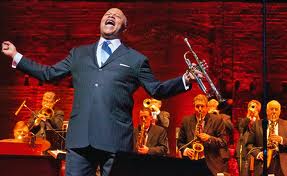The Jazz Audience Initiative, a 21-month research project of Columbus, Ohio’s Jazz Arts Group, has posted its final reports and scheduled a webinar for October 21 (free registration available) to discuss them. Among the main points:
- Musical tastes are socially transmitted.
- Jazz has relatively diverse audiences.
- People pay to hear specific artists.
- Local programming shapes local preferences.
- Young listeners are eclectic.
- Many paths lead to jazz.
- Jazz listeners like informal settings.

Byron Stripling leads the Columbus Jazz Arts Group Orchestra; what can draw new audiences to listen?
The JAI study, funded largely by a $200,000 grant from the Doris Duke Charitable Foundation, intended to “learn new ways for engaging audiences, and infusing the art form with new energy.” It was run by the consulting firm WolfBrown, and tapped data collected from “research partners” Jazz at Lincoln, SFJazz, the Monterey Jazz Festival, Jazz St. Louis, Scullers Jazz Club (Boston) and a consortium of university presenters.
I attended a roll-out of these findings in Columbus last August, and blogged about it. Jaded as I am about studies of jazz that are born of institution’s ways of doing things when jazz is a rather unruly and anti-institutional art form, I respond to most of the study’s determinations with, “Yeah, we knew that.” No conclusion will be striking to anyone who has presented jazz with any success (which means being able to sustain such activities) over the past 40 years or so. It’s nice to have the collected data, which can be parsed in many different ways, but hard to imagine that as boiled down into an overview the major conclusions will indeed “infuse the art form with new energy.”
What would infuse jazz with new energy? For that matter, is energy what’s needed? Jazz (however defined) has energy aplenty now — as demonstrated by such evidence as the 175 jazz degree programs featured in the November education issue of Down Beat. This is not bad, compared to some 470 degree-bearing music programs in the U.S. overall. Kids (or their parents) are spending thousands of dollars annually to learn jazz (assuming that jazz can be learned in school). My recent visits to the buzzing Berklee College of Music campus in Boston and Wesleyan University’s music program, as well as frequent peeps at the New School Jazz and Contemporary Music Program are proof positive.
What troubles jazz is not low energy, but that its income streams are mere trickles and the costs of producing jazz, while modest relative to costs of other performing arts productions, are higher than what it brings in. A presentation at the JAI’s August convening by Chamber Music America president Margaret Lioi noted that jazz clubs — those informal settings jazz lovers prefer — are beset by increasingly high rents. A study on how jazz musicians make their money is currently under way, thanks to the Future of Music Coalition, and a couple samples of the detailed questionaires that I’ve seen demonstrate that musicians scuffle for a living by addressing many different sources of funds simultaneously. None of this points to a lack of energy in jazz, unless “energy” = $.
Jazz musicians and related industries could use more money, no doubt about that, and some more respect from the broader culture, too. The bucks aren’t going to come from a consumer market that’s dominated by more popular forms, or the world of grants and philanthropy that subsidizes Western European classical music heavily, primarily through privileged institutions (there’s that word again).
Consider the JAI’s findings for what might help to raise jazz boats. The three that stand out to me are “local programming influences local preferences,” “many roads lead to jazz” and “young audiences are eclectic.” Together, they suggest that if young people are exposed on a local level to jazz — or jazz-like musics — they’ll arrive at jazz without negative prejudice. But where are young people exposed? In high school bands? Is that why jazz education has flourished?
The decline over a couple of decades of jazz on the radio has been a wound, but there is fine jazz radio still, with stations and programs on the web available to anyone with an uplink, and Sirius-XM for cars. Anyone — including eclectic youth — can find jazz for themselves for free by logging into Pandora and inputting a couple names (Miles Davis is a good one to start with, since so many stylists contemporary and historic are linked through his several artistic phases; add a good singer to get vocals). Jazz festivals, especially those with low entry fees held in municipalities where diverse audiences can easily attend, expose people of every sort to jazz in marvelously informal settings.
Some of the problems faced by jazz presenting institutions are self-inflicted. Among those are a disregard for how media to promote information of upcoming concerts and ongoing programs has changed. That issue is not taken up in the Jazz Audience Initiative study, but ought to be a focus of another project sometime, because media, as always and by definition, carries messages, and to get energy (aka buzz?) up, a presenter better figure out what media the desired audience is involved with and how that audience expects to be addressed.
Until that happens, jazz will be heard by people who find out about it from friends, neighbors, kinfolk and schoolteachers; they’ll pay most attention to what’s immediately around them; they’ll go places where they are socially comfortable to listen, hang out and interact. That’s been the pattern since jazz was born, which the basic findings of the Jazz Audience Initiative haven’t unearthed but rather reaffirm.
howardmandel.com
Subscribe by Email |
Subscribe by RSS |
Follow on Twitter
All JBJ posts |
